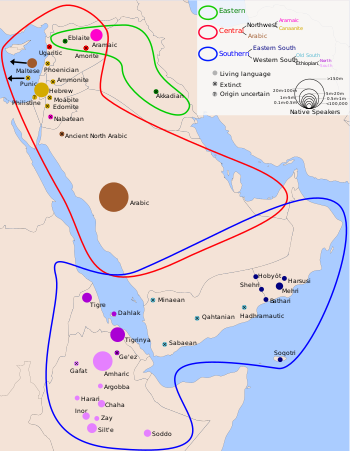South Semitic languages
 From Wikipedia - Reading time: 7 min
From Wikipedia - Reading time: 7 min
| South Semitic | |
|---|---|
| Geographic distribution | Yemen, Oman, Ethiopia, Eritrea, Sudan |
| Linguistic classification | Afro-Asiatic
|
| Subdivisions | |
| Language codes | |
| Glottolog | None |
Approximate historical distribution of South Semitic languages | |
South Semitic is a putative branch of the Semitic languages, which form a branch of the larger Afro-Asiatic language family, found in (North and East) Africa and Western Asia.
History
[edit]The "homeland" of the South Semitic languages is still debated amongst researchers, with sources such as A. Murtonen (1967) and Lionel Bender (1997)[1] suggesting an origin in Ethiopia and others suggesting the southern portion of the Arabian Peninsula.[2]
A 2009 study by Andrew Kitchen and Christopher Ehret amongst others, based on using a Bayesian model to estimate language change, concluded that the latter viewpoint is more probable, with origins in Southern Arabia, and subsequent migration into the Horn of Africa around 2800 years ago.[3] This statistical analysis could not estimate when or where the ancestor of all Semitic languages diverged from Afroasiatic, but it suggested that the divergence of the East, Central, and South Semitic branches occurred in the Levant around 5750 years ago.[4] German linguist Winfried Noth claimed that the ancestors of Ethiopians spoke a non-Semitic language (or languages, such as Cushitic languages) before adopting Semitic,.[5] Evidence for movements across South Arabia are consistent with some recent genomic findings,[6] which find strong association with the movement and ancestry of human population groups speaking the Afro-Asiatic Semitic languages. The dates matched with the origin of the Semitic languages in the Levant, and a spread during the early Bronze Age (~5.7 KYA) into the rest of the Middle East and East Africa.[7]
According to another hypothesis supported by many scholars, Semitic originated from an offshoot of a still earlier language in North Africa and desertification made some of its speakers migrate in the fourth millennium BCE into what is now Ethiopia, others northwest into West Asia.[8]
Classification
[edit]South Semitic is divided into two uncontroversial branches:[9]
- Western
- Old South Arabian – possibly extinct, formerly believed to be the linguistic ancestors of modern South Arabian Semitic languages, modern South Arabian now being classified as Eastern South Semitic. The Razihi language and Faifi language are probably descendants.
- Ethiopian Semitic (Ethio-Semitic, Ethiosemitic, Ethiopic) on the southern coast of the Arabian Peninsula and found across the Red Sea in the Horn of Africa, mainly in modern Ethiopia and Eritrea.
- Eastern
- Modern South Arabian. These languages are spoken mainly by small minority populations on the Arabian Peninsula in Yemen (Mahra and Soqotra) and Oman (Dhofar).
Demographics
[edit]The Ethiopian Semitic languages collectively have by far the greatest numbers of modern native speakers of any Semitic language other than Arabic. Eritrea's main languages are mainly Tigrinya and Tigre, which are North Ethiopic languages, and Amharic (South Ethiopic) is the main language spoken in Ethiopia (along with Tigrinya in the northern province of Tigray). Ge'ez continues to be used in Eritrea and Ethiopia as a liturgical language for the Orthodox Tewahedo churches.
Southern Arabian languages have been increasingly eclipsed by the more dominant Arabic (also a Semitic language) for more than a millennium. Ethnologue lists six modern members of the South Arabian branch and 15 members of the Ethiopian branch.[10]
See also
[edit]References
[edit]- ^ Bender, L. (1997). "Upside Down Afrasian". Afrikanistische Arbeitspapiere. 50: 19–34.
- ^ Hetzron, Robert (1972). Ethiopian Semitic: Studies in Classification. Manchester University Press. p. 122. ISBN 9780719011238.
- ^ Kitchen, Andrew; Ehret, Christopher; et al. (22 June 2009). "Bayesian phylogenetic analysis of Semitic languages identifies an Early Bronze Age origin of Semitic in the Near East". Proceedings of the Royal Society B: Biological Sciences. 276 (1665): 2703–2710. doi:10.1098/rspb.2009.0408. PMC 2839953. PMID 19403539.
- ^ Kitchen, A.; Ehret, C.; Assefa, S.; Mulligan, C. J. (29 April 2009). "Bayesian phylogenetic analysis of Semitic languages identifies an Early Bronze Age origin of Semitic in the Near East". Proceedings of the Royal Society B: Biological Sciences. 276 (1668): 2703–10. doi:10.1098/rspb.2009.0408. PMC 2839953. PMID 19403539.
- ^ Nöth, Winfried (2011-07-22). Origins of Semiosis: Sign Evolution in Nature and Culture. Walter de Gruyter. p. 295. ISBN 978-3-11-087750-2.
- ^ https://www.cell.com/ajhg/fulltext/S0002-9297(12)00271-6 "The estimated time (3 kya) and the geographic origin (the Levant) of the gene flow into Ethiopia are consistent with both the model of Early Bronze Age origins of Semitic languages and the reported age estimate (2.8 kya) of the Ethio-Semitic language group. They are also consistent with the legend of Makeda, the Queen of Sheba."
- ^ Almarri, Mohamed A.; Haber, Marc; Lootah, Reem A.; Hallast, Pille; Al Turki, Saeed; Martin, Hilary C.; Xue, Yali; Tyler-Smith, Chris (2021-09-02). "The genomic history of the Middle East". Cell. 184 (18): 4612–4625.e14. doi:10.1016/j.cell.2021.07.013. ISSN 0092-8674. PMC 8445022. PMID 34352227.
- ^ The Origin of the Jews: The Quest for Roots in a Rootless Age By Steven Weitzman page 69
- ^ Faber, Alice (1997). "Genetic Subgrouping of the Semitic Languages". In Hetzron, Robert (ed.). The Semitic Languages. Routledge. pp. 3–15.
- ^ "South". Ethnologue. Retrieved 2017-07-04.
 KSF
KSF